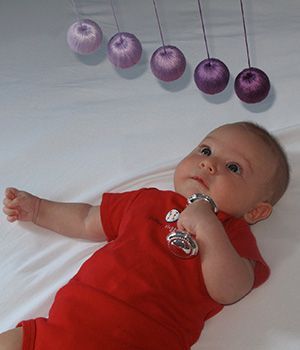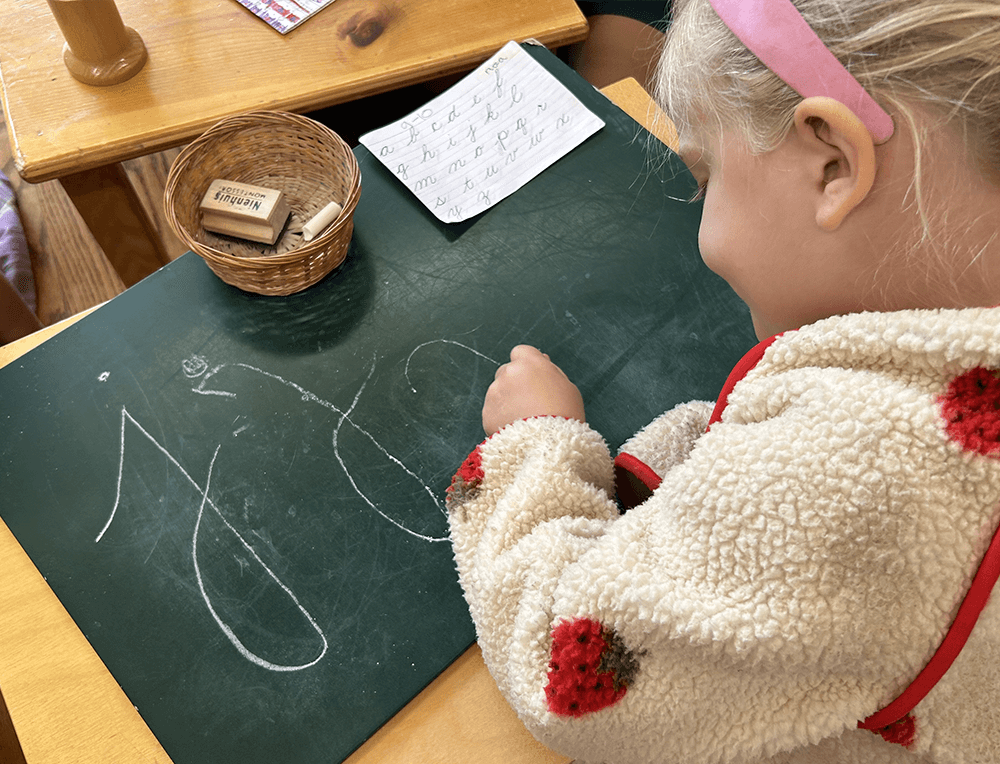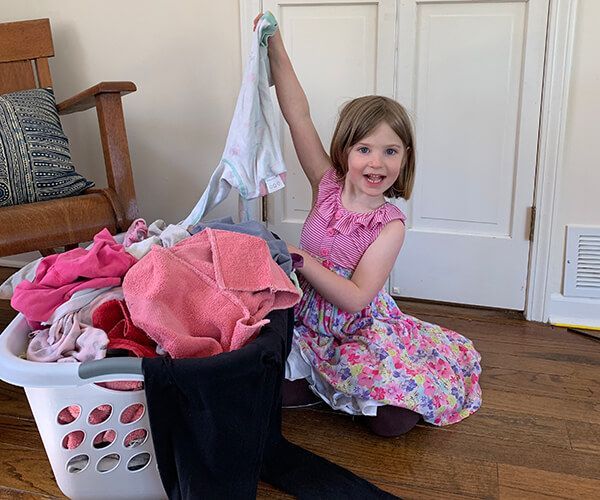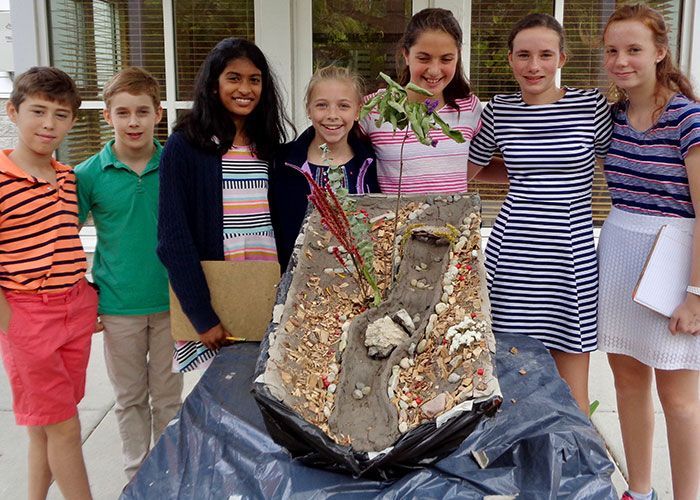
When our son was four, I was surprised to see him actually lick a photograph with his tongue. He sat back and stared at it, and then said in a bewildered tone, “Aunt Lisa’s poodle doesn’t taste like a chocolate poodle.” At the same age, our daughter waved her hand at a photograph of her grandfather and smiled. I asked her, “Do you think Grandfather can see you?” She looked at me with surprise and said, “Yes, of course—he’s looking right at me!” Such experiences remind us that even though they seem so aware of what is real and what couldn’t be, our children under age six cannot yet make these distinctions consistently.
On a Quest to Build a Person
To understand children’s perspectives and motivations, remember that from their first day of life, infants begin their quests to become complete human beings, adapted to their time, place, and culture, to connect with others and eventually, to contribute to this world. Every one of us begins with a hunger to learn as much as possible about everything around us, and we use this information to build ourselves as people—to build minds that think and know, and bodies that we can control to carry out actions as we think of them.
When Dr. Maria Montessori observed infants so long ago, she acknowledged that because infants and young children experience a unique stage of life with rapid growth—forming the foundation for their lives—we need to give special thought to their surroundings. Specifically, Montessori recognized the very intimate relationship between movement and cognition (thinking abilities) in young children. Considering this connection, it is important to present the real world to young children, as they cannot discern between reality and fantasy just yet. With no experience of the real world, they crave important information about living within it, relating to others, and working in harmony with their surroundings.
Thinking and Moving
Young children need constant opportunities to move their bodies in response to their thoughts. We must allow and encourage them to think and move simultaneously because this relationship between movement and cognition is so fundamental to human thought structures, to understanding the world around us, and to becoming effective. Specifically, this helps infants and young children to understand their surroundings and develop their spatial awareness and understanding of their world. This means that virtual experiences with screens—or even looking at books and images—cannot replace the developmental impact of a real experience of moving one’s body to explore the world.
It has been proven that when infants, for example, are not permitted to move and, instead, are carried through areas (such as infants in car seat carriers), this reduces their cognition. In Montessori: The Science Behind the Genius, Dr. Angeline Lillard explains:
“Studies have shown that when people move themselves through space, both real and imagined, they are better able to represent that space than when they are passively moved through it or do not move at all. In one study, ten-month-olds watched as an experimenter hid a toy under one of two cloths. On four such trials, the infants were then allowed to crawl to where they could remove the cloth and get the toy, and on four other such trials, they were carried to that place (at crawling speed) by their mothers (Benson & Uzgiris, 1985). On the crawling trials, most of the infants found the toy at their first try (by removing the right cloth) on most of their trials. In contrast, only 1 of the 26 infants had this level of success when they were carried to the hiding location. The act of moving themselves in space, rather than being carried, apparently allowed the infants—all of whom were developmentally able to crawl—to better keep track of the spatial layout of the environment.” In sum, Dr. Lillard writes, “When one moves with a purpose, there is a sense in which one’s body is aligned with one’s thought. Thought guides action…Montessori education capitalizes on body-mind connections” (51).
Such studies show the importance of crawling and moving one’s own body through real space in order to create mental maps of one’s surroundings, to understand, explore, and develop one’s physical abilities. There is no known substitute for this developmental need. We can respond by putting our young children on the ground to move and encourage them to carry their own things when they can. Talking with our children about what they see and experience also aids their understanding. There is a big difference for a two-year-old who walks out of her classroom on her own two feet, carries her tote bag to the car alongside an adult, climbs into her car seat and then talks with the driver about what they are seeing out the window during the drive home. Contrast this to being picked up and carried, having the tote bag lifted from her hands, being placed in the car seat, and watching a screen during the drive while the adult talks to someone else on the phone. The first scenario helps the young child build herself, connect with her world, and connect with other people—in essence, to become human, which is her innate, driving urge.
Young children will look, listen, touch, taste, and sniff to explore their world and engage all parts of their minds and bodies. The integration that occurs during such exploration is fundamental for human development. It prepares our children’s minds and bodies for emotionally and intellectually rich and interesting lives.

Offering Reality as Much as Possible
Plastic has many terrific uses, but when it comes to toys for infants, plastic is pretty uneventful; the taste, textures, and temperature are mainly consistent. In contrast, when we can give infants toys made of real materials, such as metal, wood, or cloth, their senses experience a wider range of physical qualities: the child learns that metal can be cool and smooth, wood can be warmer and has a different texture and taste, and cloth can be soft and pliable. Infants make many distinctions with their sensitive hands, mouths, and noses as they explore objects. A stick from outside has a smell, a taste, a feel and a certain stiffness or flexibility. It may have knobs on it, tiny scratch lines, or flakes of bark coming off. There is so much to find out about something as available as a stick from outside! An infant’s mind takes in all the minute impressions and absorbs the information, enriching his thoughts and driving his movements as he pulls his head back to look at a stick, feels it with his hands, passes it from one hand to the other, touches it all over with his fingers, and even puts it in the corner of his mouth to chew on it. (Well, maybe yuck, but it’s up to you!)
Think of how this experience contrasts with a child sitting passively and tracking images on a screen with his eyes. With a screen, all the information is coming in visually, and mainly one’s eyes are distinguishing colors and movements of light images. This is a very one-dimensional experience, perhaps with a backdrop of voice, but no other sensations. One’s mind is not invited to think as the body is not invited to move. Any thinking that happens does not influence or change what is happening on the screen, so thinking is not encouraged by the activity.
Think of how this experience contrasts with a child sitting passively and tracking images on a screen with his eyes. With a screen, all the information is coming in visually, and mainly one’s eyes are distinguishing colors and movements of light images. This is a very one-dimensional experience, perhaps with a backdrop of voice, but no other sensations. One’s mind is not invited to think as the body is not invited to move. Any thinking that happens does not influence or change what is happening on the screen, so thinking is not encouraged by the activity.
Connecting Through Reality
Young children, in their desire to connect with others, need to find binding ideas to commune about. Adults and children can talk about trees, flowers, water, books, sounds, music, bodies, the sky…anything they have had mutual experiences with and have some knowledge of. These are all touch points that people can find in common. In contrast, the latest cartoon character, electronic game, icon, or fashion fad leaves some people out of the loop, and thus makes this material less available for connection with other people. Young children may find themselves isolated when they ask Grandpa about their latest favorite cartoon character, “Doraemon,” and cannot get a flicker of recognition or interest. They may be able to connect to others on this topic, but a conversation about trees is one that any person can immediately converse and connect about. The reason that talking to young children about real things is so enjoyable is because their curiosity plays to adults’ desire to share information, and we can all connect over reality.
Understanding Fantasy
There is a difference, which Dr. Montessori explained, between imaginative thought and fantasy. Fantasy is thinking of something which is not before our eyes and which does not adhere to reality. We often use the word imagine when we really mean fantasize, so this can be confusing. But there is a difference, in the way that Dr. Montessori used these words.
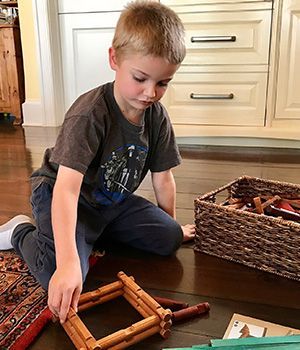
Fantasy means that you can make a complete departure from reality if you wish, which can be fun for those of us who are secure with reality. Adults have created cartoon characters to do impossible things: in movies, we can make people fly through the air; they make things explode by looking at them with their eyes; beams come out of people’s hands, and so on. We can fantasize that things can happen that cannot happen in our current reality and make them look real by using our technological inventions. But we cannot fantasize things into reality.
Fantasy explains an actual departing from reality. We say “that’s a fantasy” when we mean that it couldn’t really happen. When a person fantasizes frequently, we find that we cannot connect with them. This happens with adults as well as with children. When a child comes into a classroom and spends the day fantasizing that objects in the room are talking to one another and flying through the room, for instance, the adults and children around them have a hard time connecting in conversation and working with that child. To be productive, we need to start by connecting in a base of reality.
In contrast, there is a direct connection between imagination and reality. A person who has studied the laws of physics can use that knowledge of reality to imagine something new which does not yet exist and then—in reality—create that thing. We can also imagine how another person may feel, or, when reading a novel, we can picture a scene and empathize with the emotions of the characters as they are described to us through the written word. We can have an emotionally transforming experience. This is the imagination at work.
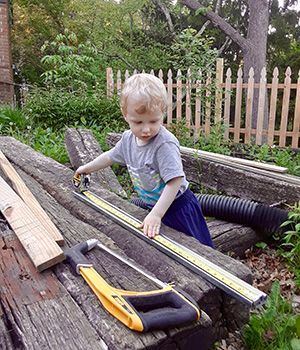
Imagination is incredibly important, and Dr. Montessori believed that it should be employed and exercised when it begins to emerge in children most strongly, between ages six and twelve. This doesn’t mean that children do not imagine before age six, but this is the stage of life when it emerges most powerfully and productively. Being capable of telling the difference between fantasy (that couldn’t really happen, perhaps ever) and imagination (I am picturing something that could happen but is not in front of me right now and may not even exist yet) starts to occur consistently around age six, when enough experience with reality gives children a base for making this distinction. This is when their minds actually start to reason and think more abstractly. Young children under age six crave experience with the real world around them because they have a natural drive to collect information to feed this important ability to imagine.
What Young Children Need
The main takeaway is to give your infants and young children real experiences in their immediate surroundings. Avoid movies, TV programs, cartoons, and books which are the product of other people’s creations, and allow your children to touch, feel, and be active in the immediate, real world. So much important development is happening every day in young children’s minds, bodies, and personalities from being active and connecting with other people and immediate surroundings. All in good time, your older children will begin to use their imaginations to create new things, to dramatize possible social relations, and to play for hours, using their own, unique imaginations. With developed imaginations that grow out of real experiences in the real world, our children will invent and create many beautiful, useful, and brilliant things and find solutions that will make this world an even better place.

Suggested Toys & Items
Here is a list of Suggested Gifts for Children, according to age. The items on this list provide a range of sensorial experiences and allow children to engage with the real world, rather than screens.
Additional Reading
Pretend Play and Fantasy: What if Montessori was Right?
by Angeline S. Lillard and Jessica Taggart

